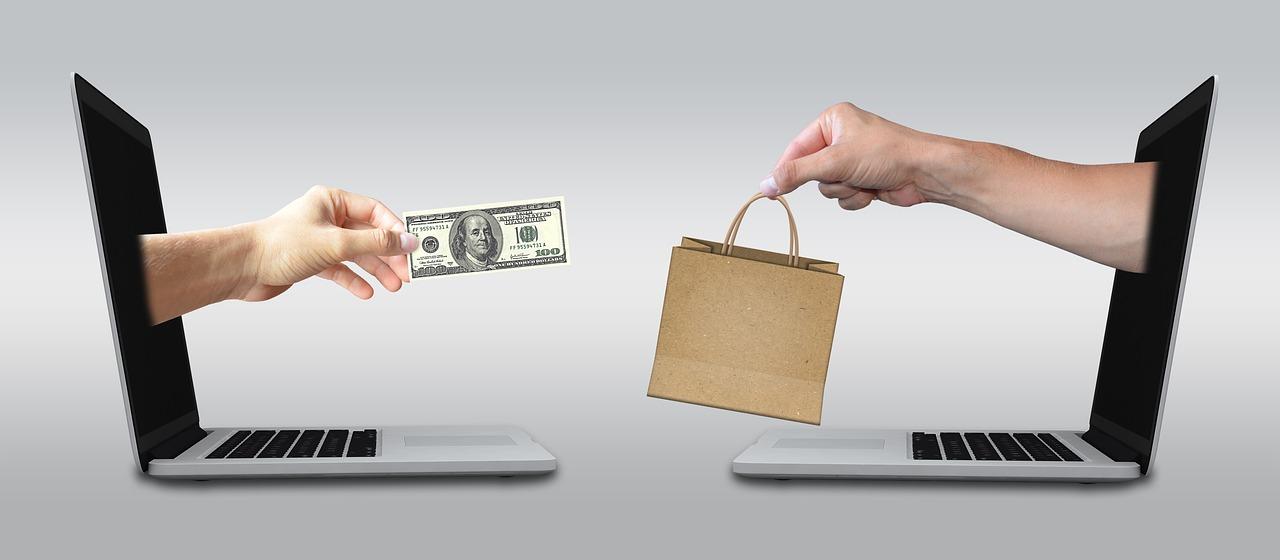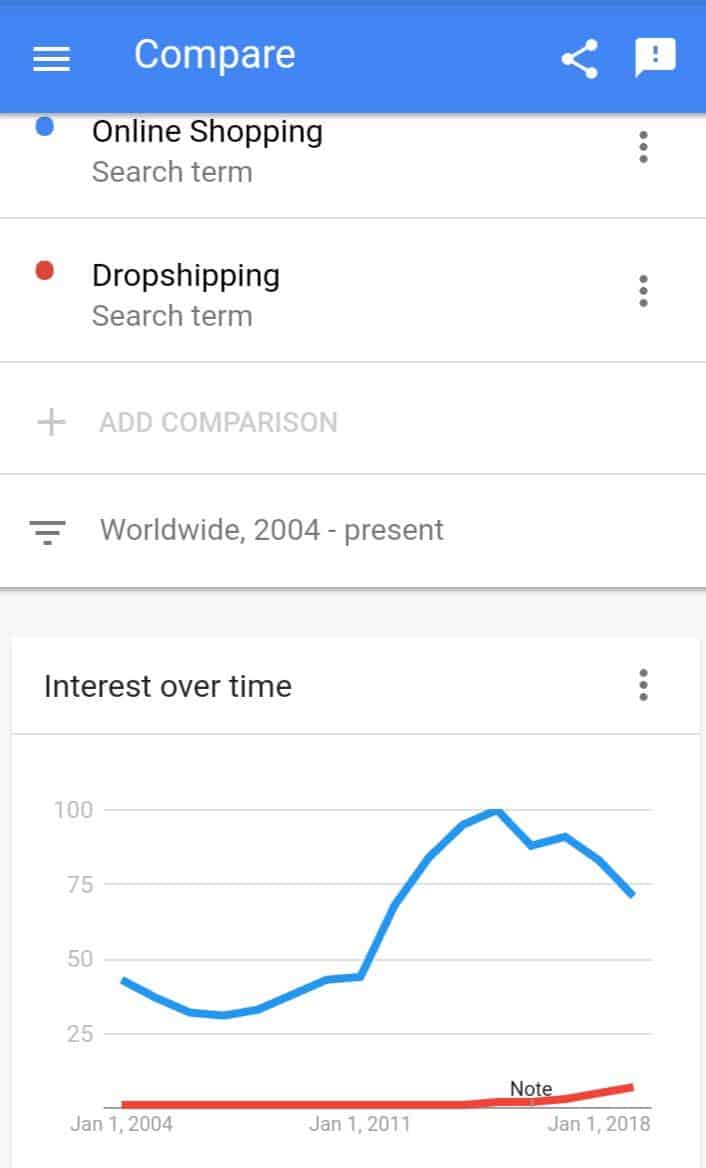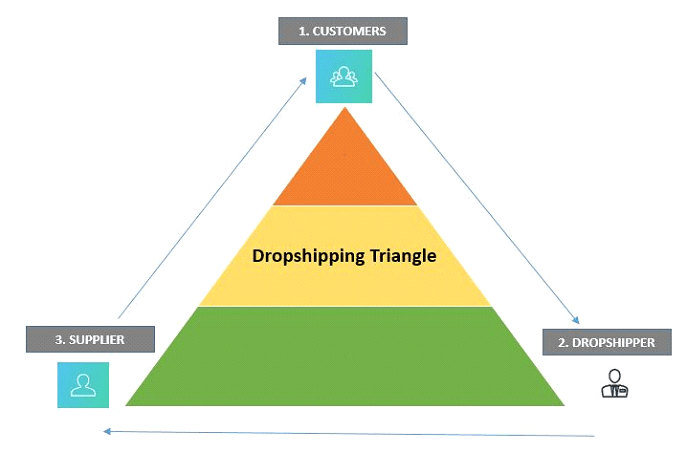
How much would you like to grow your dropshipping business this year, 2x, 5x, 10x? The good news is, whatever your growth goals are, with the right strategies, tools and approach you can reach them.
With global online retail sales racing to a whopping $4.88tr per year come 2021, smart dropshippers are eyeing emerging markets as internet access further spreads to new territories, even as more and more people now prefer to shop online, thanks to factors like
- Mobile Shopping
- Convenience
- Competition
- Competitive Pricing
- Speedy Delivery
- 24/7 Access
- Global Availability
- Product Variety
- Social Commerce
- Technology (AI, VR, Programmatic Commerce, etc),
Which are all helping to push this trend.
And speaking of trends, the following chart shows just how online shopping and dropshipping have trended since 2004.
Google Trends of Online Shopping vs Dropshipping

From the charts above we observe that dropshipping as a share of online shopping has been on the rise between 2004 and 2018.
This is good news for new and intending dropshippers.
Speaking of news, if dropshipping is news or new to you, here’s
What Dropshipping Is Like

Image Credit: Amos Onwukwe
- Customers place orders with dropshippers who merely displayed product pictures obtained from suppliers.
- Dropshippers take their profit and forward cost price, customer and order details to suppliers.
- Suppliers pick, pack and ship orders to customers anywhere in the world.
Dropshipping allows anyone, anywhere to participate in online retail without needing to buy or own stock, or keep inventory. With a website and virtual stock from thousands of suppliers, you’re set to start your own dropshipping business.
In case you’ve tried and failed at other online businesses and have become a little hesitant about dropshipping or online businesses in general, here’s
Why Dropshipping is so Cool and a No Brainer
There’s no doubt that one of the most important aspects of an ecommerce business is finding products that customers will buy. Not all products are suitable for dropshipping. To minimise time and maximise your returns, it is wise to use product research tools, like SaleSource which allows you to find winning products that you can sell in your online store, hassle free.
- Easy to start
- Low start up cost (less than $100)
- Zero stock
- Zero inventory
- No need for warehouse
- Can be done anywhere worldwide
- Can sell globally
- Work from home
- Be your own boss
- Zero commute to and fro
- Unlimited income potential
- Freedom to set your price and price rules
- Earn foreign exchange, etc
Whether you’re a dropshipping veteran, currently in the trenches, or an old newbie, here are
7 Battle-Tested Tips for Dropshipping Success
1. Beautiful Web Design
A beautiful, functional and easy to use website is key to dropshipping success. Think of it as your sales copy, your marketing magic wand. Smart dropshippers use their dropshipping websites to woo and wow online shoppers.
Consider
- aesthetics
- branding
- colors
- themes
- fonts
- UI
- UX
- navigation
- steps to checkout
- mobile responsiveness
- SEO
- Mobile First
- loading speed
Platforms like Shopify allow you create such beautiful, functional and fun to use ecommerce stores. You can draw some inspiration from these beautiful ecommerce stores. Here are some best shopify stores for inspiration.
2. Think Apps
As you scale, you may want to create a custom app for your dropshipping store. This will help you offer even more personalized service to your customers including push notifications, instant updates, faster browsing, brand awareness, etc.
Consider
- Aesthetics
- Branding
- Colors
- Themes
- Fonts
- UI
- UX
- Navigation
- Steps to checkout
- Security
- Analytics
- Updates
- Push notifications
Platforms like AppyPie allow you create native Android apps without coding (by drag and drop) and publish instantly to Google Play Store.
3. Dropshipping Apps
Apps, plugins and extensions give your store superpowers, it’s like dropshipping on steroids. These tools are constantly developed to cater to different areas of your dropshipping business not covered by your ecommerce platform.
Consider
- Cost
- Reviews and ratings
- Size
- Installs
- Supported themes
- Integration
- Updates
- Customer complaints
- Support
- Security
- Scalability
- Usability
- Functions and features
Apps like Oberlo are perfect for dropshipping automation for Shopify hosted stores. There are apps for store design, marketing, shipping, payment, etc.
4. Product Photography
In ecommerce, product photography is an important purchase factor. This is because most purchase decisions are based entirely on what shoppers think of a product judging by its looks.
Consider
- Lighting
- Camera
- Backgrounds
- Colors
- Editing
- Angles
- 360° views
- Details
- Cost
- Multiple shots
- Size
- Format
- Naming
Online shoppers will judge your book(store) by its cover, so ensure you’re using the best product photos. Tools like Folio simplify this process.
5. Explainer Videos
Videos drive engagement and are widely used in content marketing, with billions of hours of videos on platforms like YouTube. Explainer videos are great for dropshipping. You can use them to explain products, process, etc.
Consider
- Your market
- Your niche
- Cost
- Budget
- Crew
- Equipment
- Time
- Size
- Length
- Content/copy
- Sub-titles
- Calls to action
- Branding
Explainer videos well conceived, created and delivered can improve dwell time, customer engagement and conversion and retention. Tools like Blender allows you edit your videos like a pro.
6. Continuous Learning
Trends change. Algorithms change. People change. The best way to survive these changes is to keep abreast of them all as much as you can. Dropshipping is evolving and dropshippers need to keep pace.
Consider
- Your brand
- Your market
- News
- Blogs
- Internet
- Courses
- Trainings
- Industry reports
- Analytics
- Competitors
- Seminars
- Conferences
- Social Media
Those who stop learning, stop growing and start dying. You need (new) knowledge to keep your dropshipping business afloat in the sea of competition.
7. Social Listening
With over 3 billion active users, social media can be loud, really loud. People chat, comment, post, share, play, etc on social media. Much of this conversation is about brands and businesses. Social listening helps you monitor your mentions on social media so you can respond appropriately.
Consider
- Your brand
- Market
- Demographics
- Social networks
- Social listening tools
- Google Alerts
- Posts
- Comments
- Feedback
- Support staff
- Live Chat
- Other communication channels
- Average response time
One wrong mention by a powerful Influencer can ruin your dropshipping business. And a good mention or recommendation can do wonders. Both can be tracked via social listening.
Conclusion
There are many factors that contribute to dropshipping success or failure. Implementing these eight tips listed above will set you apart and give you an early start.
Let us know which or what has worked for you.
About the Guest Author
Amos Onwukwe is an AWAI trained Business and Ecommerce Copywriter featured in Huffington Post, Dumb Little Man, Self Growth, Ecommerce Nation, eCommerce Insights, Understanding Ecommerce, Result First, Floship, Successful Startup 101, Small Biz Club, Small Business Bonfire, among others.
You can find him on Twitter @amos_onwukwe

